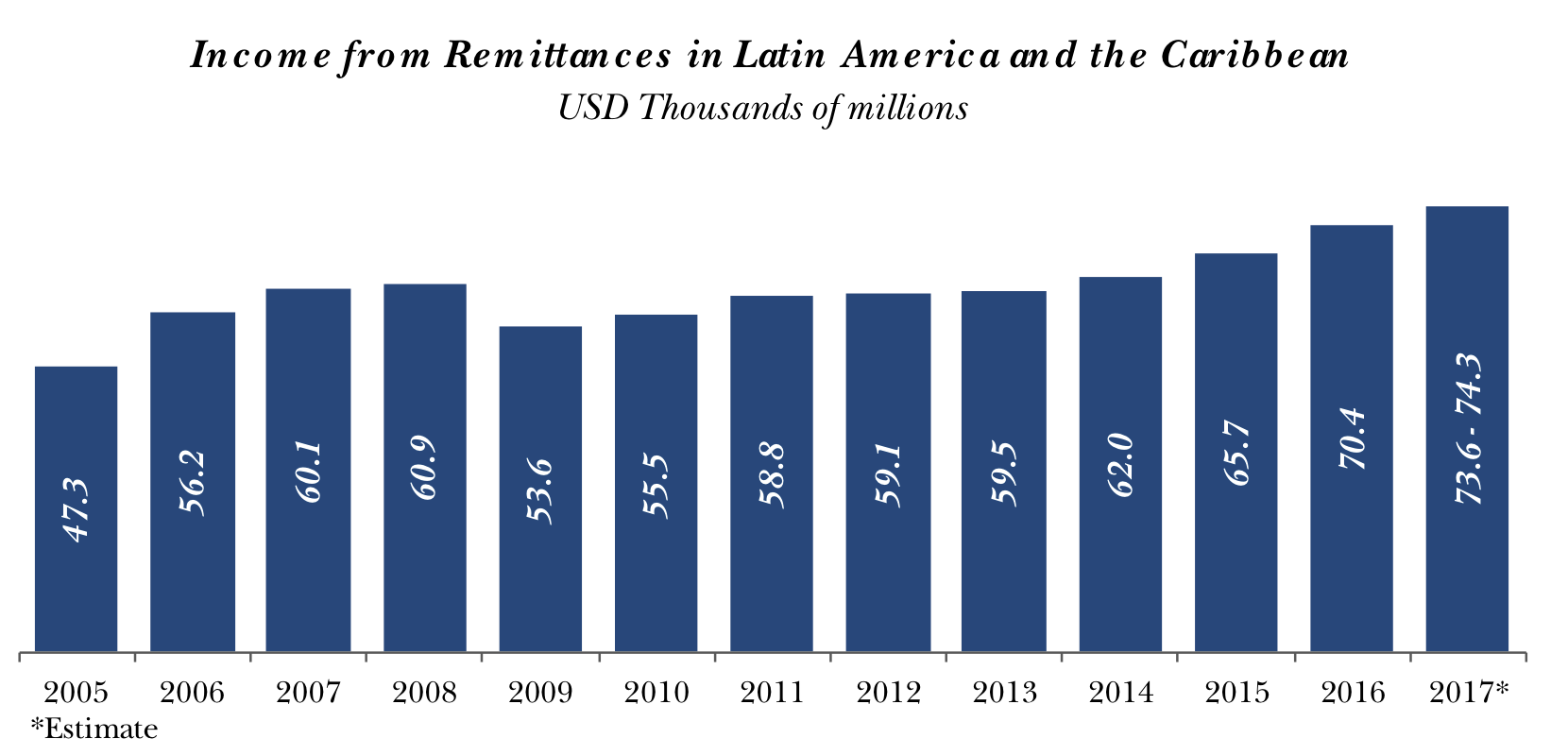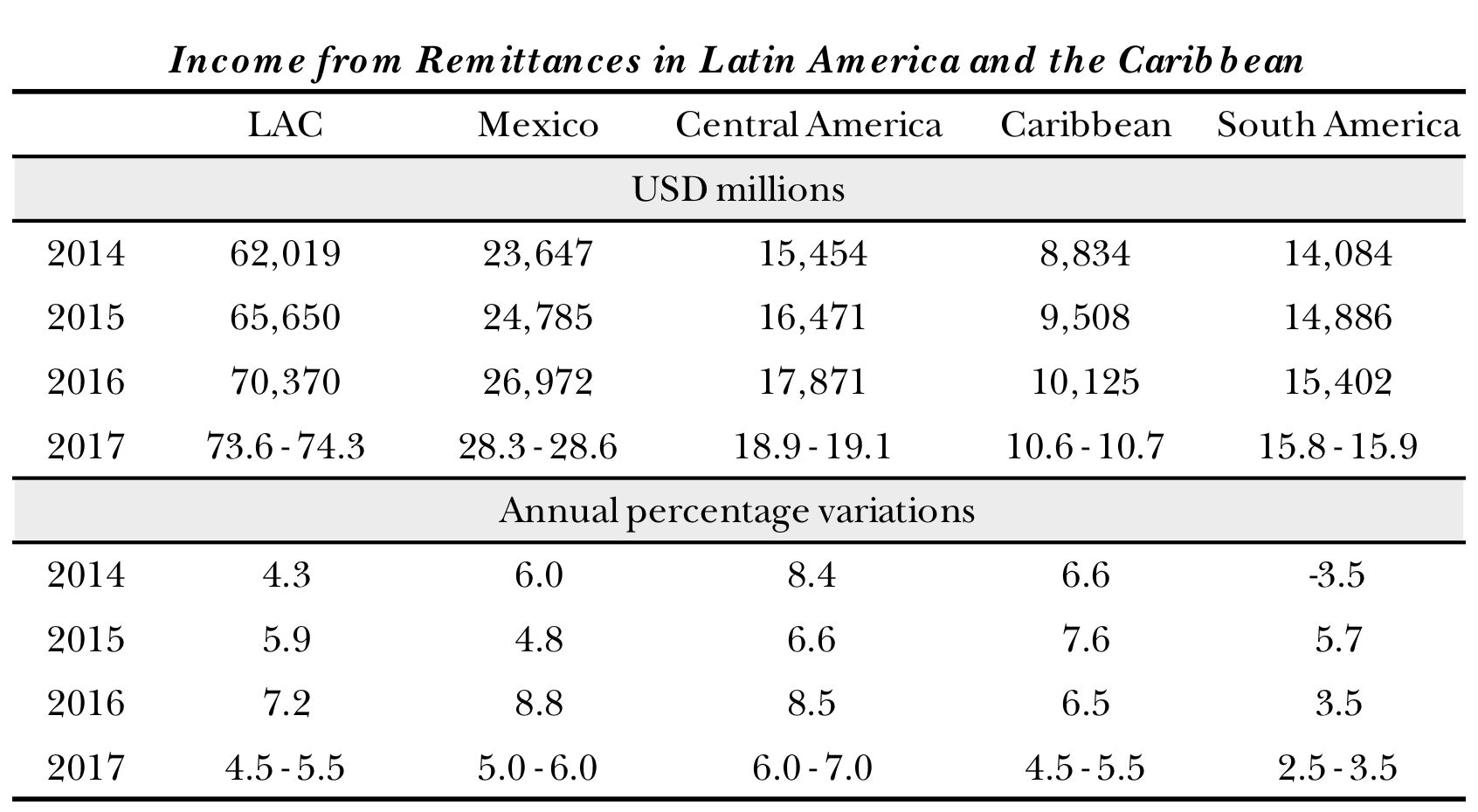Remittances to Latin America and the Caribbean in 2016:
A New Record*
Program of Remittances and Financial Inclusion
The Center for Latin American Monetary Studies (CEMLA) and the Multilateral Investment Fund (MIF) of the Inter-American Development Bank (IBD) group published the report “Remittances to Latin America and the Caribbean in 2016: A New Record” showing the evolution that year of remittance flows to the region and their estimates for 2017.
The report shows how remittances to the region of Latin America and the Caribbean set a new record in 2016 that had a very positive impact on millions of recipient households and their standards of living. The most important aspects characterizing the behavior of such inflows were:
- remittances amounted to 70,369 million of USD, after having accumulated increases for 7 consecutive years;
- the annual growth of these inflows was 7.2%, which represents the highest growth rate recorded in the past 10 years;
- the increase in remittances was generalized throughout all the different subregions; and
- stemmed from, among other factors, higher employment, average wages and, consequently, the total wage bill for migrant workers from the region in the main destination countries.
The behavior of remittances in the different subregions is described in the following paragraphs.
Central America. Remittances received by Central American countries reached unprecedented levels in 2016, amounting to 17,871 million of USD, with an annual growth of 8.5%, the highest observed in the last six years. This performance resulted from the expansion of remittances received by Guatemala (13.9%), El Salvador (7.2%) and Nicaragua (5.9%), offset by reductions in such inflows in Panamá (−9.9%), and, to a lesser extent, in Costa Rica (−0.5%).
Mexico. In 2016, remittance flows to Mexico represented 38.3% of the total remittances received by Latin America and the Caribbean. That year, this inflow to Mexico amounted to 26,972 million of USD, with an annual growth of 8.8%, a record figure given that after nine years it finally surpassed the previous record of 26,059 million of USD set in 2007. The main factor explaining said increase in remittances is the positive evolution in the United States of employment, average wages and the total wage bill for immigrant workers originating from Mexico. In particular, during 2016, employment levels among such workers did not exhibit an annual increase as had occurred in 2014 and 2015, but there were new increases in average wages and the total wage bill.
Caribbean. Remittances received in 2016 by the group of Caribbean countries amounted to 10,125 million of USD with an annual increase of 6.5%, which was slightly below that observed one year before. The growth of remittances received by Haiti and Dominican Republic stands out, recording rates of 11.3% and 6.1%, respectively.
South America. In contrast to Mexico and Central American countries, where remittances mainly originate from the United States, in the South American region Spain is also a significant source of such flows. Moreover, the varying levels of development and different economic conditions observed in each country of this region results in wage differences that foster intraregional migration and the corresponding remittance flows, which leads to a different behavior of these flows compared to what happens in other subregions. Under this framework of reference, during 2016, remittance flows to South America amounted to 15,402 million of USD, with growth of 3.5%, meaning such inflows did not surpass the previous record levels reached in 2008.
Remittance Income for the Group of Latin American and Caribbean Countries Will Set A New Record In 2017
The report of CEMLA and the MIF highlights that for 2017, the growth rate of remittances received by LAC countries is expected to slow as a result of the factors listed below.
- Although there is still no information on the evolution of migration flows to the United States so far this year, indicators exist which show these have been decreasing since 2015.
- Changes to immigration policies announced by the new US administration have still not been established, meaning it is not possible to estimate their likely impact on remittance flows originating from that country.
- Forecasts from the International Monetary Fund (IMF) signal a decrease in the growth rate of the Spanish economy and a modest economic recovery in the United States in 2017 as compared to 2016.
- However, it should be mentioned that the IMF states that the forecast for the United States is subject to several potential risks that could lead to lower growth rates. In addition, the IMF forecast for economic activity in the South American region during 2017 is for growth of just 0.6% (see the table below), which could affect intraregional migration flows between countries of this subregion and, thereby, intraregional remittance flows.

Based on the above, CEMLA and the MIF estimate that in 2017 income from remittances in the LAC region will set a new record, amounting to between 73.6 billion and 74.3 billion of USD as a result of a significant annual increase of between 4.5% and 5.5%. Said rate would represent slower growth compared to that observed in 2016 and is expected to be shared across all the different subregions.

*The report was prepared by: René Maldonado, coordinator of the Remittances and Financial Inclusion Program (CEMLA); Jesús Cervantes, Manager of Economic Statistics and coordinator of the Forum for Remittances in Latin America and the Caribbean at CEMLA, and Salvador Bonilla, Deputy Manager of Economic Statistics (CEMLA). The document also benefited from comments and suggestions by Fermín Vivanco and Lukas Keller of the MIF; and technical support from Cindy Sánchez of CEMLA.


